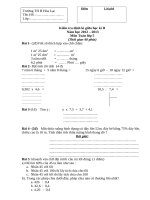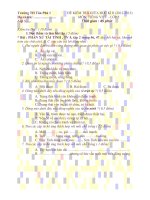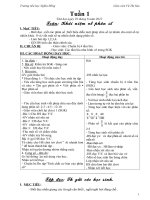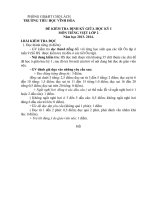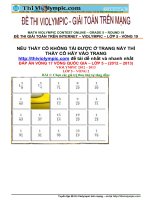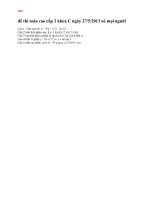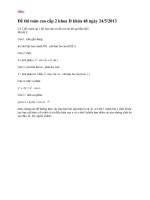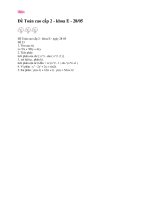Iec 60730 2 5 2013
Bạn đang xem bản rút gọn của tài liệu. Xem và tải ngay bản đầy đủ của tài liệu tại đây (508.89 KB, 108 trang )
®
Edition 4.0 2013-11
INTERNATIONAL
STANDARD
NORME
INTERNATIONALE
Automatic electrical controls –
Part 2-5: Particular requirements for automatic electrical burner control systems
IEC 60730-2-5:2013
Dispositifs de commande électrique automatiques –
Partie 2-5: Exigences particulières pour les systèmes de commande électrique
automatiques des brûleurs
Copyrighted material licensed to BR Demo by Thomson Reuters (Scientific), Inc., subscriptions.techstreet.com, downloaded on Nov-27-2014 by James Madison. No further reproduction or distribution is permitted. Uncontrolled when printe
IEC 60730-2-5
All rights reserved. Unless otherwise specified, no part of this publication may be reproduced or utilized in any form
or by any means, electronic or mechanical, including photocopying and microfilm, without permission in writing from
either IEC or IEC's member National Committee in the country of the requester.
If you have any questions about IEC copyright or have an enquiry about obtaining additional rights to this publication,
please contact the address below or your local IEC member National Committee for further information.
Droits de reproduction réservés. Sauf indication contraire, aucune partie de cette publication ne peut être reproduite ni
utilisée sous quelque forme que ce soit et par aucun procédé, électronique ou mécanique, y compris la photocopie et les
microfilms, sans l'accord écrit de la CEI ou du Comité national de la CEI du pays du demandeur.
Si vous avez des questions sur le copyright de la CEI ou si vous désirez obtenir des droits supplémentaires sur cette
publication, utilisez les coordonnées ci-après ou contactez le Comité national de la CEI de votre pays de résidence.
IEC Central Office
3, rue de Varembé
CH-1211 Geneva 20
Switzerland
Tel.: +41 22 919 02 11
Fax: +41 22 919 03 00
www.iec.ch
About the IEC
The International Electrotechnical Commission (IEC) is the leading global organization that prepares and publishes
International Standards for all electrical, electronic and related technologies.
About IEC publications
The technical content of IEC publications is kept under constant review by the IEC. Please make sure that you have the
latest edition, a corrigenda or an amendment might have been published.
Useful links:
IEC publications search - www.iec.ch/searchpub
Electropedia - www.electropedia.org
The advanced search enables you to find IEC publications
by a variety of criteria (reference number, text, technical
committee,…).
It also gives information on projects, replaced and
withdrawn publications.
The world's leading online dictionary of electronic and
electrical terms containing more than 30 000 terms and
definitions in English and French, with equivalent terms in
additional languages. Also known as the International
Electrotechnical Vocabulary (IEV) on-line.
IEC Just Published - webstore.iec.ch/justpublished
Customer Service Centre - webstore.iec.ch/csc
Stay up to date on all new IEC publications. Just Published
details all new publications released. Available on-line and
also once a month by email.
If you wish to give us your feedback on this publication
or need further assistance, please contact the
Customer Service Centre:
A propos de la CEI
La Commission Electrotechnique Internationale (CEI) est la première organisation mondiale qui élabore et publie des
Normes internationales pour tout ce qui a trait à l'électricité, à l'électronique et aux technologies apparentées.
A propos des publications CEI
Le contenu technique des publications de la CEI est constamment revu. Veuillez vous assurer que vous possédez
l’édition la plus récente, un corrigendum ou amendement peut avoir été publié.
Liens utiles:
Recherche de publications CEI - www.iec.ch/searchpub
Electropedia - www.electropedia.org
La recherche avancée vous permet de trouver des
publications CEI en utilisant différents critères (numéro de
référence, texte, comité d’études,…).
Elle donne aussi des informations sur les projets et les
publications remplacées ou retirées.
Le premier dictionnaire en ligne au monde de termes
électroniques et électriques. Il contient plus de 30 000
termes et définitions en anglais et en franỗais, ainsi que
les termes ộquivalents dans les langues additionnelles.
Egalement
appelé
Vocabulaire
Electrotechnique
International (VEI) en ligne.
Just Published CEI - webstore.iec.ch/justpublished
Restez informé sur les nouvelles publications de la CEI.
Just Published détaille les nouvelles publications parues.
Disponible en ligne et aussi une fois par mois par email.
Service Clients - webstore.iec.ch/csc
Si vous désirez nous donner des commentaires sur
cette publication ou si vous avez des questions
contactez-nous:
Copyrighted material licensed to BR Demo by Thomson Reuters (Scientific), Inc., subscriptions.techstreet.com, downloaded on Nov-27-2014 by James Madison. No further reproduction or distribution is permitted. Uncontrolled when printe
THIS PUBLICATION IS COPYRIGHT PROTECTED
Copyright © 2013 IEC, Geneva, Switzerland
®
Edition 4.0 2013-11
INTERNATIONAL
STANDARD
NORME
INTERNATIONALE
Automatic electrical controls –
Part 2-5: Particular requirements for automatic electrical burner control systems
Dispositifs de commande électrique automatiques –
Partie 2-5: Exigences particulières pour les systèmes de commande électrique
automatiques des brûleurs
INTERNATIONAL
ELECTROTECHNICAL
COMMISSION
COMMISSION
ELECTROTECHNIQUE
INTERNATIONALE
PRICE CODE
CODE PRIX
ICS 97.120
XA
ISBN 978-2-8322-1171-7
Warning! Make sure that you obtained this publication from an authorized distributor.
Attention! Veuillez vous assurer que vous avez obtenu cette publication via un distributeur agréé.
® Registered trademark of the International Electrotechnical Commission
Marque déposée de la Commission Electrotechnique Internationale
Copyrighted material licensed to BR Demo by Thomson Reuters (Scientific), Inc., subscriptions.techstreet.com, downloaded on Nov-27-2014 by James Madison. No further reproduction or distribution is permitted. Uncontrolled when printe
IEC 60730-2-5
60730-2-5 © IEC:2013
CONTENTS
FOREWORD ........................................................................................................................... 4
1
Scope and normative references ....................................................................................... 6
2
Definitions ........................................................................................................................ 7
3
General requirements ..................................................................................................... 14
4
General notes on tests .................................................................................................... 14
5
Rating ............................................................................................................................. 15
6
Classification .................................................................................................................. 15
7
Information ..................................................................................................................... 17
8
Protection against electric shock ..................................................................................... 20
9
Provision for protective earthing ...................................................................................... 20
10 Terminals and terminations ............................................................................................. 20
11 Constructional requirements ........................................................................................... 21
12 Moisture and dust resistance .......................................................................................... 27
13 Electric strength and insulation resistance ....................................................................... 27
14 Heating ........................................................................................................................... 28
15 Manufacturing deviation and drift .................................................................................... 29
16 Environmental stress ...................................................................................................... 30
17 Endurance ...................................................................................................................... 31
18 Mechanical strength ........................................................................................................ 34
19 Threaded parts and connections ..................................................................................... 34
20 Creepage distances, clearances and distances through solid insulation ........................... 34
21 Resistance to heat, fire and tracking ............................................................................... 34
22 Resistance to corrosion .................................................................................................. 34
23 Electromagnetic compatibility (EMC) requirements – emission......................................... 34
24 Components ................................................................................................................... 34
25 Normal operation ............................................................................................................ 34
26 Electromagnetic compatibility (EMC) requirements – immunity ........................................ 34
27 Abnormal operation ......................................................................................................... 35
28 Guidance on the use of electronic disconnection ............................................................. 35
Annex H (normative) Requirements for electronic controls .................................................... 36
Annex J (normative) Requirements for controls using thermistors ......................................... 49
Annex BB (informative) Functional characteristics of burner control systems to be
specified by the relevant appliance standards, as applicable .................................................. 50
Bibliography .......................................................................................................................... 51
Figure 101 – Pulse spark generation ..................................................................................... 20
Figure H.2 (H.26.5.4.2 of the previous version) – Voltage variation test .................................. 39
Table 1 (7.2 of the previous edition) (1 of 2) .......................................................................... 18
Table H.1 (7.2 of the previous edition) ................................................................................... 36
Table H.101 – Voltage dips, short interruptions and voltage variations ................................... 37
Copyrighted material licensed to BR Demo by Thomson Reuters (Scientific), Inc., subscriptions.techstreet.com, downloaded on Nov-27-2014 by James Madison. No further reproduction or distribution is permitted. Uncontrolled when printe
–2–
–3–
Table H.13 (Table H.26.5.4.2 of the previous edition) – Timing of short-term supply
voltage variations .................................................................................................................. 38
Table H.102 – Test level for electrical fast transient burst ...................................................... 41
Table H.103 – Peak voltages ................................................................................................. 42
Table H.104 – Test levels for electrostatic discharge ............................................................. 43
Table H.105 – Test levels for conducted disturbances on mains and I/O lines ........................ 44
Table H.18 (Table H.26.12.3.1 of the previous edition) – Immunity to radiated
electromagnetic fields ........................................................................................................... 45
Table BB.1 – Functional characteristics of burner control systems to be specified by the
relevant appliance standards, as applicable ........................................................................... 50
Copyrighted material licensed to BR Demo by Thomson Reuters (Scientific), Inc., subscriptions.techstreet.com, downloaded on Nov-27-2014 by James Madison. No further reproduction or distribution is permitted. Uncontrolled when printe
60730-2-5 © IEC:2013
60730-2-5 © IEC:2013
INTERNATIONAL ELECTROTECHNICAL COMMISSION
____________
AUTOMATIC ELECTRICAL CONTROLS –
Part 2-5: Particular requirements for automatic
electrical burner control systems
FOREWORD
1) The International Electrotechnical Commission (IEC) is a worldwide organization for standardization comprising
all national electrotechnical committees (IEC National Committees). The object of IEC is to promote
international co-operation on all questions concerning standardization in the electrical and electronic fields. To
this end and in addition to other activities, IEC publishes International Standards, Technical Specifications,
Technical Reports, Publicly Available Specifications (PAS) and Guides (hereafter referred to as “IEC
Publication(s)”). Their preparation is entrusted to technical committees; any IEC National Committee interested
in the subject dealt with may participate in this preparatory work. International, governmental and nongovernmental organizations liaising with the IEC also participate in this preparation. IEC collaborates closely
with the International Organization for Standardization (ISO) in accordance with conditions determined by
agreement between the two organizations.
2) The formal decisions or agreements of IEC on technical matters express, as nearly as possible, an international
consensus of opinion on the relevant subjects since each technical committee has representation from all
interested IEC National Committees.
3) IEC Publications have the form of recommendations for international use and are accepted by IEC National
Committees in that sense. While all reasonable efforts are made to ensure that the technical content of IEC
Publications is accurate, IEC cannot be held responsible for the way in which they are used or for any
misinterpretation by any end user.
4) In order to promote international uniformity, IEC National Committees undertake to apply IEC Publications
transparently to the maximum extent possible in their national and regional publications. Any divergence
between any IEC Publication and the corresponding national or regional publication shall be clearly indicated in
the latter.
5) IEC itself does not provide any attestation of conformity. Independent certification bodies provide conformity
assessment services and, in some areas, access to IEC marks of conformity. IEC is not responsible for any
services carried out by independent certification bodies.
6) All users should ensure that they have the latest edition of this publication.
7) No liability shall attach to IEC or its directors, employees, servants or agents including individual experts and
members of its technical committees and IEC National Committees for any personal injury, property damage or
other damage of any nature whatsoever, whether direct or indirect, or for costs (including legal fees) and
expenses arising out of the publication, use of, or reliance upon, this IEC Publication or any other IEC
Publications.
8) Attention is drawn to the Normative references cited in this publication. Use of the referenced publications is
indispensable for the correct application of this publication.
9) Attention is drawn to the possibility that some of the elements of this IEC Publication may be the subject of
patent rights. IEC shall not be held responsible for identifying any or all such patent rights.
International Standard IEC 60730-2-5 has been prepared by IEC technical committee 72:
Automatic electrical controls.
The text of this standard is based on the following documents:
FDIS
Report on voting
72/922/FDIS
72/929/RVD
Full information on the voting for the approval of this standard can be found in the report on
voting indicated in the above table.
This publication has been drafted in accordance with the ISO/IEC Directives, Part 2.
Copyrighted material licensed to BR Demo by Thomson Reuters (Scientific), Inc., subscriptions.techstreet.com, downloaded on Nov-27-2014 by James Madison. No further reproduction or distribution is permitted. Uncontrolled when printe
–4–
–5–
This part 2-5 is intended to be used in conjunction with IEC 60730-1. It was established on the
basis of the fourth edition (2010) of that publication. Consideration may be given to future
editions of, or amendments to, IEC 60730-1.
The title of IEC 60730-2-5 Ed. 4 has been updated to the title of IEC 60730-1 Ed. 5.0. However,
IEC 60730-2-5 Ed. 4.0 has not been updated in accordance with the technical requirements in
IEC 60730-1 Ed. 5.0.
This part 2-5 supplements or modifies the corresponding clauses in IEC 60730-1 so as to
convert that publication into the IEC standard: Safety requirements for automatic electrical
burner control systems.
Where this part 2-5 states "addition", "modification", or "replacement", the relevant
requirement, test specification or explanatory matter in Part 1 should be adapted accordingly.
Where no change is necessary, this part 2-5 indicates that the relevant clause or subclause
applies.
In the development of a fully international standard, it has been necessary to take into
consideration the differing requirements resulting from practical experience in various parts of
the world and to recognize the variation in national electrical systems and wiring rules.
The “in some countries” notes regarding differing national practices are contained in the following subclauses:
–
2.3.127
–
6.11
–
15.7
–
17.16.102.1
–
H.26.11.103
–
Table H.21, Note 7
In this publication:
1) The following print types are used:
–
Requirements proper: in roman type;
–
Test specifications: in italic type;
–
Explanatory matter; in small roman type;
–
Words defined in Clause 2: bold.
2) Subclauses, notes, tables and figures which are additional to those in Part 1 are numbered
starting from 101, additional annexes are lettered AA, BB, etc.
A list of all parts of the IEC 60730 series, under the general title Automatic electrical controls
can be found on the IEC website.
The committee has decided that the contents of this publication will remain unchanged until the
stability date indicated on the IEC web site under "" in the data related to
the specific publication. At this date, the publication will be
•
•
•
•
reconfirmed,
withdrawn,
replaced by a revised edition, or
amended.
Copyrighted material licensed to BR Demo by Thomson Reuters (Scientific), Inc., subscriptions.techstreet.com, downloaded on Nov-27-2014 by James Madison. No further reproduction or distribution is permitted. Uncontrolled when printe
60730-2-5 © IEC:2013
60730-2-5 © IEC:2013
AUTOMATIC ELECTRICAL CONTROLS –
Part 2-5: Particular requirements for automatic
electrical burner control systems
1
Scope and normative references
This clause of Part 1 is applicable except as follows:
1.1
Replacement:
This part of IEC 60730 applies to automatic electrical burner control systems for the automatic
control of burners for oil, gas, coal or other combustibles for household and similar use
including heating, air conditioning and similar use.
This part 2-5 is applicable to a complete burner control system and to a separate
programming unit. This part 2-5 is also applicable to a separate electronic high-voltage
ignition source and to a separate flame detector.
NOTE Separate ignition devices (electrodes, pilot burners, etc.) are not covered by this part 2-5 unless they are
submitted as part of a burner control system. Requirements for separate ignition transformers are contained in
IEC 60989.
Throughout this part 2-5, where it can be used unambiguously, the word "system" means
"burner control system" and "systems" means "burner control systems".
Systems utilizing thermoelectric flame supervision are not covered by this part 2-5.
1.1.1 This part 2-5 applies to the inherent safety, to the manufacturer's declared operating
values, operating times and operating sequences where such are associated with burner
safety and to the testing of automatic electrical burner control systems used in, on, or in
association with, burners.
NOTE Requirements for specific operating values, operating times and operating sequences are given in the
standards for appliances and equipment.
Systems for equipment not intended for normal household use, but which nevertheless may be
used by the public, such as equipment intended to be used by laymen in shops, in light industry
and on farms, are within the scope of this part 2-5.
This part 2-5 applies to systems using NTC or PTC thermistors, additional requirements for
which are contained in Annex J.
This part 2-5 does not apply to systems designed exclusively for industrial applications.
1.1.2 This part 2-5 applies to manual controls when such are electrically and/or mechanically
integral with automatic controls.
NOTE
Requirements for manual switches not forming part of an automatic control are contained in IEC 61058-1.
Throughout this part 2-5, the word "equipment" means "appliance and equipment".
Copyrighted material licensed to BR Demo by Thomson Reuters (Scientific), Inc., subscriptions.techstreet.com, downloaded on Nov-27-2014 by James Madison. No further reproduction or distribution is permitted. Uncontrolled when printe
–6–
1.2
–7–
Replacement:
This part 2-5 applies to systems with a rated voltage not exceeding 660 V and with a rated
current not exceeding 63 A.
1.3
Replacement:
This part 2-5 does not take into account the response value of an automatic action of a
control, if such a response value is dependent upon the method of mounting the control in the
equipment. Where a response value is of significant purpose for the protection of the user, or
surroundings, the value defined in the appropriate household equipment standard or as
determined by the manufacturer applies.
NOTE
1.4
This part 2-5 includes systems responsive to flame properties.
Replacement:
This part 2-5 applies also to systems incorporating electronic devices, requirements for which
are contained in Annex H.
1.5
Normative references
This clause of Part 1 is applicable except as follows:
Addition:
IEC 60068-2-6, Environmental testing – Part 2: Tests – Test Fc: Vibration (sinusoidal)
IEC 61643-11, Low-voltage surge protective devices – Part 11: Surge protective devices
connected to low-voltage power systems – Requirements and test methods
2
Definitions
This clause of Part 1 is applicable except as follows:
2.2
Definitions of types of control according to purpose
Additional definitions:
2.2.101
burner control system
system which includes a programming unit, a flame detector and may include an ignition
source and/or ignition device and which monitors the operation of fuel burners
Note 1 to entry: The various functions of the system may be in one or more housings.
Copyrighted material licensed to BR Demo by Thomson Reuters (Scientific), Inc., subscriptions.techstreet.com, downloaded on Nov-27-2014 by James Madison. No further reproduction or distribution is permitted. Uncontrolled when printe
60730-2-5 © IEC:2013
60730-2-5 © IEC:2013
2.2.102
flame detector
device which provides the programming unit with a signal indicating the presence or absence
of flame
Note 1 to entry: It includes the flame sensor and may include an amplifier and a relay for signal transmission. The
amplifier and relay may be in its own housing or combined with the programming unit.
2.2.103
flame sensor
device which senses the flame and provides the input signal to the flame detector amplifier
Note 1 to entry: Examples are optical sensors and flame electrodes (flame rods).
2.2.104
ignition source
electrical or electronic system component which provides energy to an ignition device
Note 1 to entry: It may be separated from or incorporated in the programming unit. Examples are ignition
transformers and electronic high-voltage generators.
2.2.105
ignition device
device mounted on or adjacent to a burner for igniting fuel at the burner
Note 1 to entry: Examples are pilot burners, spark electrodes and hot surface igniters.
2.2.106
programming unit
device which controls the burner operation in a declared sequence from start-up to shut-down
within declared timings and in response to signals from regulating, limiting and monitoring
devices
2.2.107
multitry system
system that allows more than one valve open period during its declared operating sequence
2.3
Definitions relating to the function of controls
2.3.30
T max
Replace "switch head" by "burner control system."
Additional definitions:
2.3.101
automatic recycle
automatic repetition of the start-up procedure, without manual intervention, following loss of the
supervised flame and subsequent fuel supply shutoff
2.3.102
controlled shut-down
de-energization of the fuel flow means as a result of the opening of a control loop by a control
device such as a thermostat leading the system to return to the start position
Note 1 to entry: Controlled shut-down may include additional actions by the system.
Copyrighted material licensed to BR Demo by Thomson Reuters (Scientific), Inc., subscriptions.techstreet.com, downloaded on Nov-27-2014 by James Madison. No further reproduction or distribution is permitted. Uncontrolled when printe
–8–
–9–
2.3.103
flame detector response time
period of time between the loss of the sensed flame and the signal indicating the absence of
flame
2.3.104
flame detector operating characteristics
that function of the flame detector which indicates absence or presence of flame as the output
signal of the flame detector relating to the input signal
Note 1 to entry: Normally the input signal is provided by a flame sensor.
2.3.104.1
signal for presence of flame
S1
minimum signal which indicates the presence of flame when there was previously no flame
2.3.104.2
signal for absence of flame
S2
maximum signal which indicates the loss of flame
Note 1 to entry: S 2 is less than S 1 .
2.3.104.3
maximum flame signal
S max
maximum signal which does not affect the timings or the sequence
2.3.104.4
signal for visible light flame simulation
S3
minimum signal which indicates the presence of flame during the visible light flame simulation
test
Note 1 to entry: S 3 is less than S 2 .
2.3.105
self-checking flame detector
flame detector which checks for correct operation of the flame detector and its associated
electronic circuitry while the burner is in the running position
2.3.106
flame detector self-checking rate
frequency of the self-checking function of the flame detector (in number of operations per
unit of time)
2.3.107
flame failure lock-out time
period of time between the signal indicating absence of flame and lock-out
2.3.108
flame failure re-ignition time
relight time
period of time between the signal indicating absence of flame and the signal to energize the
ignition device, during which the fuel supply is not shut off
Copyrighted material licensed to BR Demo by Thomson Reuters (Scientific), Inc., subscriptions.techstreet.com, downloaded on Nov-27-2014 by James Madison. No further reproduction or distribution is permitted. Uncontrolled when printe
60730-2-5 © IEC:2013
60730-2-5 © IEC:2013
2.3.109
flame signal
output signal of the flame detector
2.3.110
flame simulation
condition which occurs when the flame detector indicates the presence of flame when in
reality no flame is present
2.3.111
ignition time
period of time during which the ignition device is energized
2.3.112
lock-out
process in which the system goes into one of the following lock-out conditions, following
safety shut-down
2.3.112.1
non-volatile lock-out
condition such that a restart can only be accomplished by a manual reset of the system and by
no other cause
2.3.112.2
volatile lock-out
condition such that a restart can be accomplished by either a manual reset of the system or by
an interruption of the power supply and its subsequent restoration
2.3.113
main flame establishing period
period of time between the signal to energize the main fuel flow means and the signal
indicating presence of the main burner flame
2.3.114
pilot flame establishing period
period of time between the signal to energize the pilot fuel flow means and the signal
indicating presence of the pilot flame
2.3.115
post-ignition time
period of the ignition time between the signal indicating presence of flame and the signal to
de-energize the ignition device
2.3.116
pre-ignition time
period of the ignition time between the signal to ignite and the signal to energize the fuel flow
means
2.3.117
proved igniter
system in which the fuel flow means is energized only after the availability of sufficient energy
to ignite the fuel has been verified
Note 1 to entry: Examples are systems using spark supervision and those using proved hot surface igniters.
Copyrighted material licensed to BR Demo by Thomson Reuters (Scientific), Inc., subscriptions.techstreet.com, downloaded on Nov-27-2014 by James Madison. No further reproduction or distribution is permitted. Uncontrolled when printe
– 10 –
– 11 –
2.3.117.1
proved igniter operating value
signal which indicates that the proved igniter has the energy to ignite the fuel
2.3.117.2
igniter proving time
period of time between the signal to energize the proved igniter and the signal to energize the
fuel flow means
2.3.117.3
igniter failure response time
period of time between loss of the supervised proved igniter and the signal to de-energize the
fuel flow means
2.3.118
purge time
period during which air is introduced to displace any remaining air/fuel mixtures or products of
combustion from the combustion zone and flue ways
Note 1 to entry: No fuel is admitted during this period.
2.3.118.1
post-purge time
purge time that takes place immediately following the shutting off of the fuel supply
2.3.118.2
pre-purge time
purge time that takes place between initiation of a burner control sequence and the
admission of fuel to the burner
2.3.119
re-ignition
relight
process by which, following loss of the flame signal, the ignition device will be re-energized
without interruption of the fuel flow means
2.3.120
recycle time
period of time between the signal to de-energize the fuel flow means following the loss of flame
and the signal to begin a new start-up procedure
2.3.121
running position
position denoting that the main burner flame is established and supervised
2.3.122
safety shut-down
de-energization of the main fuel flow means as the result of the action of a limiter, a cut-out or
the detection of an internal fault of the system
Note 1 to entry: Safety shut-down may include additional actions by the system.
2.3.123
start position
position which denotes that the system is not in the lock-out condition and has not yet received
the start signal, but can proceed with the start-up sequence if required
Copyrighted material licensed to BR Demo by Thomson Reuters (Scientific), Inc., subscriptions.techstreet.com, downloaded on Nov-27-2014 by James Madison. No further reproduction or distribution is permitted. Uncontrolled when printe
60730-2-5 © IEC:2013
60730-2-5 © IEC:2013
2.3.124
start signal
signal, for example, from a thermostat, which releases the system from its start position
2.3.125
start-up lock-out time
period of time between the signal to energize the fuel flow means and lock-out
Note 1 to entry: For systems which control two separate fuel flow means, two different start-up lock-out times are
possible (first and second start-up lock-out times).
2.3.126
waiting time
period between the start signal and the signal to energize the ignition device
Note 1 to entry: For burners without fans, natural ventilation of the combustion chamber and the flue passages
normally takes place during this time.
2.3.127
valve open period
for multitry systems, the period of time between the signal to energize the fuel flow means,
and the signal to de-energize the fuel flow means, if proof of the supervised burner flame is not
established
Note 1 to entry: In the USA, this period is referred to as the "trial-for-ignition period."
2.3.128
valve sequence period
for multitry systems, the sum of all valve opening periods prior to lock-out, if proof of the
supervised burner flame is not established
2.3.129
system restart
process by which, after a safety shut-down, a full start-up procedure is automatically repeated
2.3.130
reset from lock-out function
function that provides reset from lock-out allowing the system to attempt a restart
Note 1 to entry: The reset function may be performed by various electric/electronic (mobile) devices.
2.3.131
common cause failures
failures of different items, resulting from a single event, where these failures are not
consequences of each other
Note 1 to entry: Common cause failures should not be confused with common mode failures.
[SOURCE: IEC 60050-191:1990,191-04-23]
Copyrighted material licensed to BR Demo by Thomson Reuters (Scientific), Inc., subscriptions.techstreet.com, downloaded on Nov-27-2014 by James Madison. No further reproduction or distribution is permitted. Uncontrolled when printe
– 12 –
2.5
– 13 –
Definitions of types of control according to construction
Additional definitions:
2.5.101
system for permanent operation
system which is intended to remain in the running position for longer than 24 h without
interruption
2.5.102
system for non-permanent operation
system which is intended to remain in the running position for less than 24 h
Additional definitions:
2.101
Definitions relating to the type of burner (see 6.101)
2.101.1
continuous ignition
type of ignition which, once placed in operation, is intended to remain energized continuously
until it is manually interrupted
2.101.2
continuous pilot
pilot which, once placed in operation, is intended to remain ignited continuously until it is
manually interrupted
2.101.3
direct ignition
type of ignition which is applied directly to the main burner, without the use of a pilot
2.101.4
expanding pilot
form of continuous pilot where the pilot flame is increased or expanded when required to
ignite the main burner and reduced either immediately after main burner ignition, or after the
main flame is shut off
2.101.5
full rate start
condition in which the main burner ignition and subsequent flame supervision occur at full
fuel rate
2.101.6
intermittent ignition
type of ignition which is energized when an appliance is called on to operate and which remains
continuously energized during each period of main burner operation and where the ignition is
de-energized when the main burner operating cycle is completed
Copyrighted material licensed to BR Demo by Thomson Reuters (Scientific), Inc., subscriptions.techstreet.com, downloaded on Nov-27-2014 by James Madison. No further reproduction or distribution is permitted. Uncontrolled when printe
60730-2-5 © IEC:2013
60730-2-5 © IEC:2013
2.101.7
intermittent pilot
pilot which is automatically ignited when an appliance is called on to operate and which
remains continuously ignited during each period of main burner operation and where the pilot
is automatically extinguished when each main burner operating cycle is completed
2.101.8
interrupted ignition
type of ignition which is energized prior to the admission of fuel to the main burner and which is
de-energized when the main flame is established
2.101.9
interrupted pilot
pilot which is automatically ignited prior to the admission of fuel to the main burner and which
is automatically extinguished when the main flame is established
2.101.10
low rate start
condition in which main burner ignition occurs at low fuel rate
Note 1 to entry: Once ignition at low fuel rate occurs and the flame is proved, full main burner fuel rate may be
admitted.
2.101.11
pilot
flame, smaller than the main flame, which is utilized to ignite the main burner or burners
3
General requirements
This clause of Part 1 is applicable.
4
General notes on tests
This clause of Part 1 is applicable except as follows:
4.1
Conditions of test
4.1.1
Replacement:
Unless otherwise specified, the system and each system component are tested as delivered,
having been mounted as declared in Table 1 (7.2 of the previous edition), requirement 31, in
the most unfavourable position when there is more than one position.
When a separate system component is submitted, the manufacturer shall provide those other
system components which may be necessary to perform the relevant tests.
4.1.7
Not applicable.
4.2
Samples required
4.2.1
Replacement:
Unless otherwise specified, one sample shall be used for the tests of Clauses 5 to 14 inclusive.
A different sample(s) shall be used for the tests of Clauses 15 to 17. At the option of the
manufacturer, the tests of Clauses 18 to 26 inclusive may be conducted on a new sample or on
Copyrighted material licensed to BR Demo by Thomson Reuters (Scientific), Inc., subscriptions.techstreet.com, downloaded on Nov-27-2014 by James Madison. No further reproduction or distribution is permitted. Uncontrolled when printe
– 14 –
– 15 –
the sample(s) used for the tests of Clauses 5 to 14 inclusive. The tests of Clause 27 shall be
conducted on a new sample.
4.3
Instructions for test
4.3.2.1
Modification:
Delete "and those for a.c./d.c. at the more unfavourable supply."
4.3.2.4
Not applicable.
4.3.2.6
Replacement:
For systems marked or declared for more than one rated voltage or rated current, the tests of
Clause 17 are made at the rated voltage and associated current (or vice versa) which produces
the most unfavourable combination.
5
Rating
This clause of Part 1 is applicable.
6
Classification
This clause of Part 1 is applicable except as follows:
6.1
According to nature of supply
6.1.1
Systems for a.c. only
Replace explanatory matter by the following requirement:
Systems intended for use on a.c. only supply shall only be used on a.c. supplies.
6.1.3
6.3
Not applicable.
According to their purpose
Additional subclauses:
6.3.101
–
burner control system;
6.3.102
–
flame detector;
6.3.103
–
programming unit;
6.3.104
–
ignition device;
6.3.105
–
electronic high-voltage ignition source;
6.3.106
–
flame sensor.
6.4
According to features of automatic action
6.4.1
Not applicable.
6.4.3
Addition:
Copyrighted material licensed to BR Demo by Thomson Reuters (Scientific), Inc., subscriptions.techstreet.com, downloaded on Nov-27-2014 by James Madison. No further reproduction or distribution is permitted. Uncontrolled when printe
60730-2-5 © IEC:2013
60730-2-5 © IEC:2013
Burner control systems are classified as having Type 2 action.
6.4.3.12
Not applicable.
Additional subclauses:
6.4.3.101
–
non-volatile lock-out (Type 2.V);
6.4.3.102
–
volatile lock-out (Type 2.W);
6.4.3.103
–
non-permanent operation (Type 2.AC);
6.4.3.104
–
permanent operation (Type 2.AD);
6.4.3.105
–
spark supervision (Type 2.AE);
6.4.3.106
–
air/pressure flow supervision (Type 2.AF);
6.4.3.107
–
position-checked external devices (Type 2.AG);
6.4.3.108
–
visible light flame simulation check (Type 2.AH);
6.4.3.109
–
proved hot surface igniter (Type 2.AI).
6.7
According to ambient temperature limits of the switch head
6.7.1
Modification:
Replace "Control with a switch head" by "System and system components".
6.7.2
Modification:
Replace "Control with a switch head" by "System and system components".
6.10
According to number of cycles of actuation (M) of each manual action
6.10.5 to 6.10.7
6.11
Not applicable.
According to number of automatic cycles (A) of each automatic action
Addition:
NOTE In the countries members of CENELEC, the minimum value is 250 000 automatic cycles. In Canada, China,
in Japan and the USA, the minimum value is 100 000 cycles.
6.11.4 to 6.11.12
6.15
6.15.3
6.16
Not applicable.
According to construction
Not applicable.
Not applicable.
Additional subclauses:
6.101
According to type of burner
NOTE Classification could be according to burner operation (for example, forced draught) and type of fuel (for
example, gas). See 2.101.1 to 2.101.11.
Copyrighted material licensed to BR Demo by Thomson Reuters (Scientific), Inc., subscriptions.techstreet.com, downloaded on Nov-27-2014 by James Madison. No further reproduction or distribution is permitted. Uncontrolled when printe
– 16 –
6.102
According to type of pilot
6.103
According to type of ignition
6.104
According to starting fuel rate
7
– 17 –
Information
This clause of Part 1 is applicable except as follows:
7.2.6
Replacement:
Except as indicated in 7.4, for integrated systems all information is provided by means of
declaration (X). For incorporated systems not declared under requirement 50, the marking
required is as indicated in Table 1 (7.2 of the previous edition). For incorporated systems
declared under requirement 50, the only marking required is the manufacturer's name or trade
mark and the unique type reference if other required marking is provided by documentation
(D).
NOTE
See the explanation of documentation (D) contained in 7.2.1.
7.2.9
Modification:
Replace "T max other than 55 °C" by "T max other than 60 °C" in the line for symbol for "Ambient
temperature limits of switch head".
Copyrighted material licensed to BR Demo by Thomson Reuters (Scientific), Inc., subscriptions.techstreet.com, downloaded on Nov-27-2014 by James Madison. No further reproduction or distribution is permitted. Uncontrolled when printe
60730-2-5 © IEC:2013
60730-2-5 © IEC:2013
Table 1 (7.2 of the previous edition) (1 of 2)
Information
Clause or subclause
Method
Modification:
Replace the following requirements by:
4
Nature of supply (a.c. or d.c.)
6
Purpose of system or system component
4.3.2, 6.1
C
4.3.5, 6.3
D
7
The type of load controlled by each
14, 17.3.1, 6.2, H.27.1.2
D
15
Degree of protection provided by enclosure 8)
6.5.1, 6.5.2, 11.5
D
17
Which of the terminals are suitable for the connection of external
conductors, and if they are suitable for line or neutral conductors,
or both
6.6, 7.4.2, 7.4.3
D
22
Temperature limits of the system and system components if T min
is lower than 0 °C, or T max other than 60 °C
6.7, 14.5, 14.7, 17.3
D
23
Temperature limits of mounting surfaces (T s )
6.12.2, 14.1, 17.3
D
6.10
X
circuit 7)
action 101)
26
Number of cycles of actuation (M) for each manual
28
Not applicable
31
Method of mounting the system and each system component 5)
4.1.1, 11.6
D
34
Details of any limitation of operating time
6.4.3.103, 6.4.3.104, 14, 17
D
37
Not applicable
38
Not applicable
40
Additional features of Type 2 actions
6.4.3
D
41
Not applicable
42
Not applicable
44
Not applicable
46
Operating sequence
2.3.13, 11.3.108, 15
D
48
Not applicable
50
System or system components intended to be delivered exclusively
to the equipment manufacturer
7.2.1, 7.2.6
X
Add the following additional requirements:
101
Maximum flame detector response time (if applicable)
2.3.103, 15
D
102
Minimum flame detector self-checking rate (if applicable)
2.3.106, 11.3.107, 15
D
103
Maximum flame failure lock-out time (if applicable)
2.3.107, 15
D
104
Maximum flame-failure re-ignition time (if applicable)
2.3.108, 15
D
105
Maximum ignition time (if applicable)
2.3.111, 15
D
106
Maximum main flame establishing period (if applicable)
2.3.113, 15
D
107
Maximum pilot flame establishing period (if applicable)
2.3.114, 15
D
108
Maximum post-ignition time (if applicable)
2.3.115, 15
D
109
Maximum pre-ignition time (if applicable)
2.3.116, 15
D
110
Void
111
Minimum post-purge time (if applicable)
2.3.118.1, 15
D
112
Minimum pre-purge time (if applicable)
2.3.118.2, 15
D
113
Minimum recycle time (if applicable)
2.3.120, 15
D
114
Maximum start-up lock-out time (if applicable)
2.3.125, 15
D
Copyrighted material licensed to BR Demo by Thomson Reuters (Scientific), Inc., subscriptions.techstreet.com, downloaded on Nov-27-2014 by James Madison. No further reproduction or distribution is permitted. Uncontrolled when printe
– 18 –
